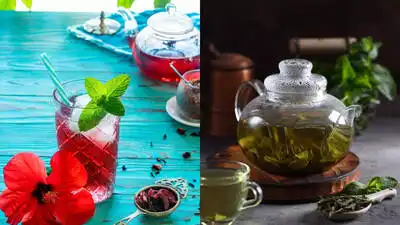They say there’s nothing a cup of tea can’t fix, and it’s true to some extent, especially when the tea in question is hibiscus tea or green tea. Both hailed as healthy beverages, hibiscus tea and green tea are known for their vibrant flavours and various health benefits. But which one is better? Hibiscus tea or green tea, when it comes to antioxidants and other benefits. Let’s take a look.
Hibiscus tea
Hibiscus tea is made from the bright coloured flowers of the hibiscus plant. The Hibiscus genus encompasses a wide variety of flowers, with blooms that differ in size and color. Some are red-orange, pink, yellow, and even white. Dried blooms are used in tea. The Roselle variety, or Hibiscus sabdariffa, is also used to make tea. It has antispastic, diuretic, and antifebrile properties, and hence the blooms are used to make tea, and the leaves are edible, with their sepals rich in organic acids, sugars, vitamins, and nutrients. Hibiscus is rich in anthocyanins and flavonoids. Research shows that hibiscus has a total phenolic content ranging from 6-20 mg/g, with anthocyanins contributing to its vibrant red hue and antioxidant capacity. A 2020 found that hibiscus can improve the immune response and reduce inflammation in rainbow trout, thus supporting the health of the fish after it is exposed to the toxic influence of ammonia. Hibiscus is rich in antioxidants, compounds that combat oxidative stress and reduce the risk of chronic diseases like heart disease and cancer.
A 2016 in people with Marfan syndrome, a disorder that affects connective tissue, found that an infusion of hibiscus extract reduced oxidative stress and increased antioxidant levels in the blood.
Video
Hibiscus tea has shown promise in managing blood pressure and cholesterol. It also reduces LDL cholesterol and triglycerides. Its diuretic properties may also support kidney health.
Green tea
Green tea has long been known to have health benefits. It is made from the leaves of the Camellia sinensis plant. These leaves are harvested, then steamed, pan-fried, or heated in a unique way to stop oxidation. Its rich in polyphenols, particularly catechins like epigallocatechin gallate (EGCG). Studies indicate green tea contains 20-45% polyphenols by weight, with EGCG being a potent antioxidant linked to anti-inflammatory and anti-cancer properties. The catechins in green tea are linked to improved cardiovascular health, weight management, and cognitive function. A 2020 of 11 studies found that green tea can help reduce body weight, body mass index (BMI), and belly fat in people with type 2 diabetes.
A 2022 in people with a cluster of heart disease risk factors has shown that consuming green tea extract for four weeks can reduce blood sugar levels and improve gut health by lowering inflammation and decreasing leaky gut. Green tea is also linked with reduced LDL cholesterol and blood pressure. The L-theanine in green tea promotes relaxation without drowsiness, and also supports mental clarity.
